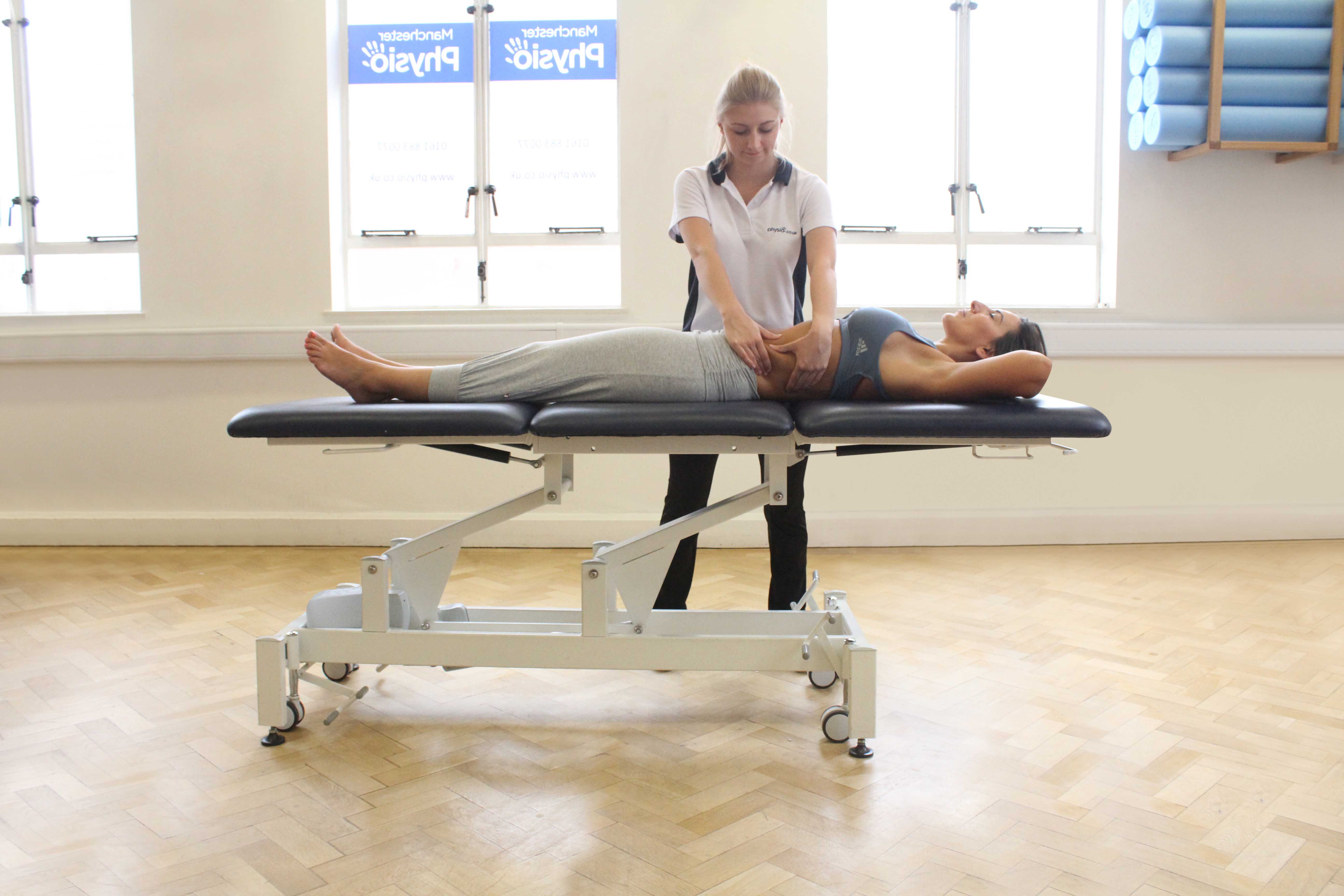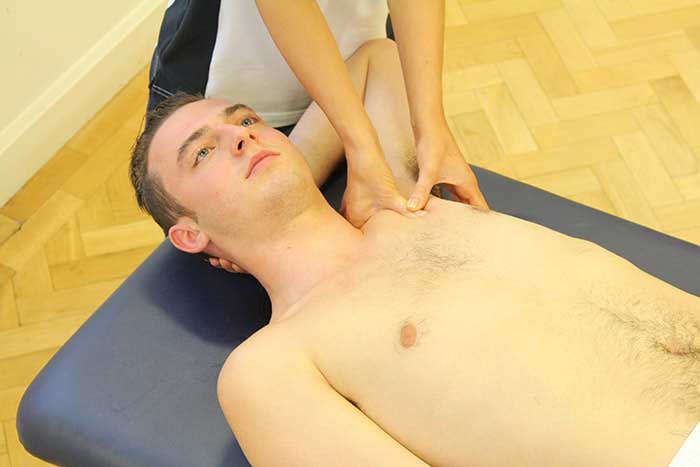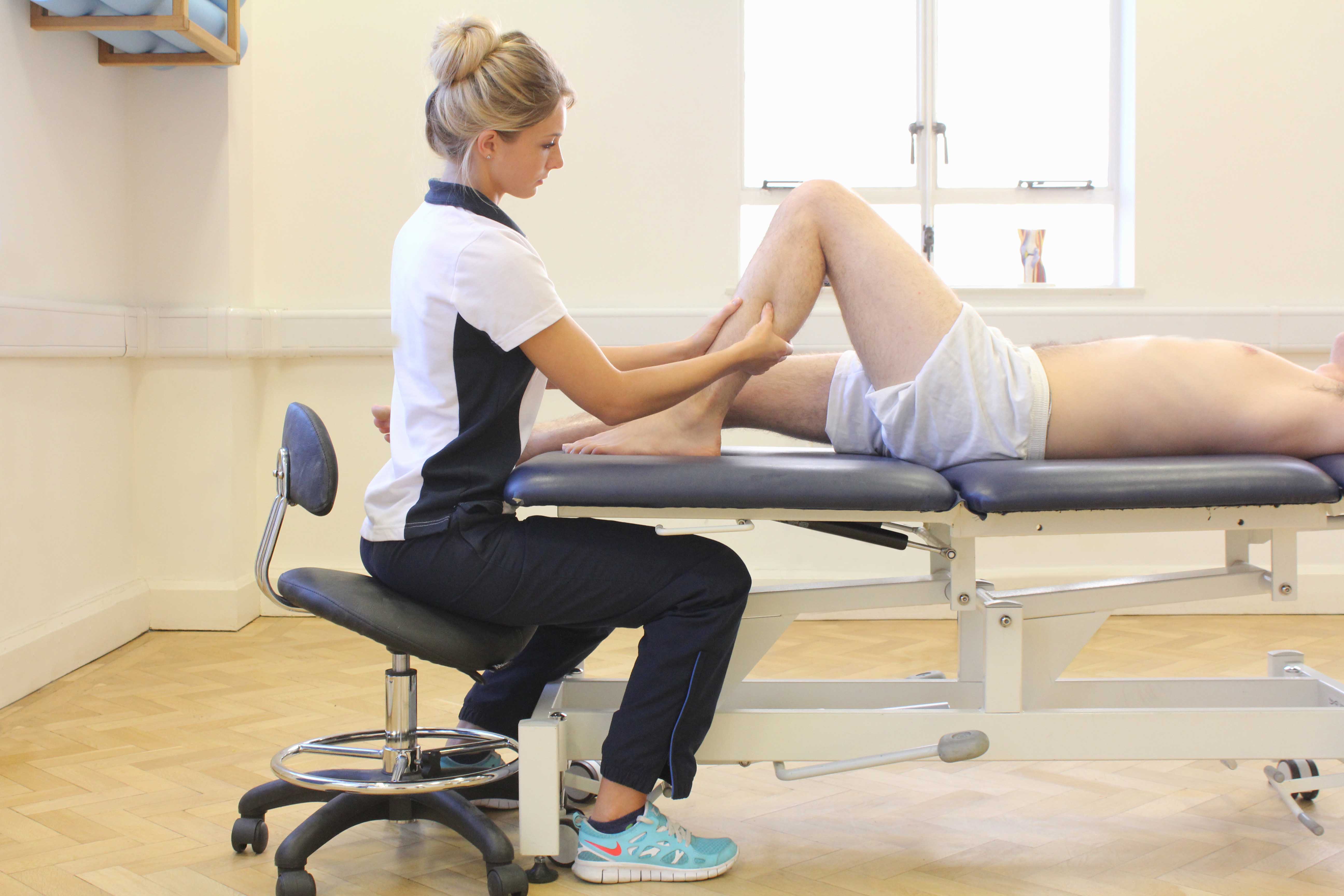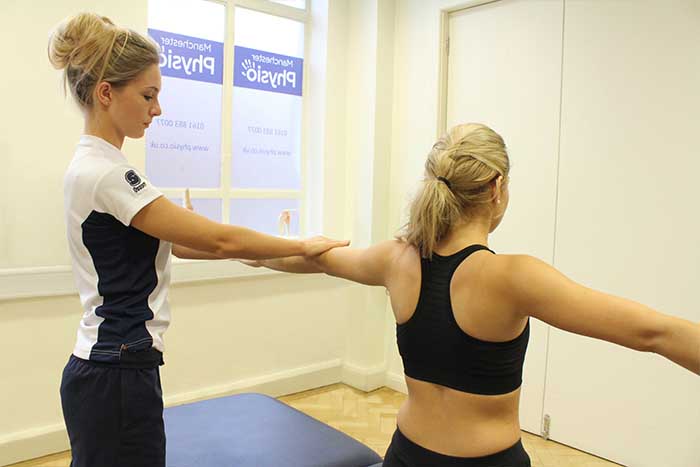A massage is regularly used to decrease pain. Pain can be caused in a variety of different ways. The most common causes of pain include injury, surgery and swelling. The feeling of pain is created in several steps within the body. Receptors in the skin detect when a form of damage has occurred to the body. The receptors then send a signal to the brain so that it can process that something isn"t right. The brain then sends a message to nerves which then create a feeling of pain. Pain can increase stress levels and restrict movement. A variety of different massages are used to help interrupt the signal sent from the brain to help reduce pain. Our massage therapists at Physio.co.uk decrease pain through massage to help increase relaxation and reduce stress.
What are the most appropriate types of massage to decrease pain?
There are many appropriate types of massage used to decrease pain. The most common types of massage used decrease pain include:
 Above: Soft tissue massage of abdominal oblique muscle
Above: Soft tissue massage of abdominal oblique muscleThe most appropriate types of massage used to decrease pain include deep tissue massage, remedial massage and Swedish massage.
Deep tissue massage is used to decrease pain. A deep tissue massage involves applying varied pressure to areas of the body containing soft tissues. The pressure used during a deep tissue massage is varied due to personal preference. A deep tissue massage helps to decrease pain as tightness and restriction within muscle tissues is reduced. A variety of techniques are used within a deep tissue massage to help increase tissue elasticity and relieve tightness therefore reducing pain.

Pain can be reduced through remedial massage. A remedial massage involves the manipulation of superficial and deep tissues to improve muscle condition and increase relaxation. A remedial massage helps to repair damaged muscles causing pain and reduce restriction that can also be contributing towards pain. A remedial massage also has a therapeutic effect on a person due to the relaxation of muscles. Increasing relaxation reduces stress. Stress can increase pain so by increasing relaxation, pain is reduced.
A Swedish massage is often used to decrease pain. A Swedish massage is a therapeutic type of massage that promotes the relaxation of a person both physically and mentally. Swedish massage can be performed with firm or gentle pressures depending on the person's preference. A Swedish massage helps to decrease tension and encourages lymphatic drainage. As well as decreasing tension and increasing lymphatic drainage, a Swedish massage increases relaxation by stimulating the nervous system. Decreasing tension and increasing lymphatic drainage and relaxation through Swedish massage all help to decrease pain.
What techniques are used to decrease pain?
A range of techniques can be used to decrease pain. The most common techniques used to decrease pain include
 Above: Soft tissue massage of Soleus muscle
Above: Soft tissue massage of Soleus muscleThe most common techniques used to decrease pain include effleurage, deep strokes and myofascial release.
Effleurage is a technique often used to decrease pain. Pain can often be caused by stiffness at a joint or tightness of muscles. Effleurage is a technique performed using varied pressure with flattened hands and fingers. The pressure applied during effleurage varies from light to firm and is used increase muscle temperature. Effleurage encourages an increase in blood flow to and around the treatment area. Increased temperature of the treatment area increases tissue elasticity and flexibility around a joint. An increase in tissue elasticity and flexibility around a joint relieves muscle stiffness and tightness. A decrease stiffness and tightness within muscles reduces pain.
Deep strokes can help to decrease pain. Deep strokes involve using flattened hands and fingers to apply a firm pressure to the treatment area. The aim of deep strokes is to get deeper within muscle tissues and fibres to help relieve tightness, tension and restriction that contribute to an increase in pain. Much like effleurage, deep strokes increase muscle temperature by the encouragement of an increase in blood flow. Inelasticity of muscle fibres and tissues is reduced when temperature increase allowing muscles to loosen and relax. A loosened and relaxed muscle decreases tightness tension and restriction, decreasing pain.
Pain can be decreased through myofascial release. Myofascial release is where flat hands and fingers are placed on top of the treatment area and are used to slowly apply pressure. Slowly applying pressure to the treatment area increases temperature of fascia. Fascia is a layer of fibrous connective tissues found beneath the skins surface that cause restriction in movement and muscle tightness, increasing pain. As temperature of fascia increases, the pressure applied to the treatment area also increases allowing the hands to get deeper within the fascia. As hands get deeper within fascia they are moved slowly around the treatment area, loosening and spreading out the fascia. Loosening and spreading out the fascia relieves restriction and muscle tightness therefore decreasing pain.

When can a massage help to decrease pain?
A massage can help to decrease pain in many situations. The most common situations a massage can help include:
Situations a massage can help to decrease pain include delayed onset muscle soreness, post injury and tight muscles.
Delayed onset muscle soreness can be helped through massage. Delayed onset muscle soreness is caused by over use or injury. Microscopic tears occur within muscle fibres causing an increase in inflammation and pain. A massage decreases pain caused by delayed onset muscle soreness by reducing inflammation and increasing healing. Inflammation is caused by a build-up of fluids that surround and injury to prevent it from further injury. Inflammation can be tender to touch and can restrict movement. A massage helps to flush out excess fluids from the injury site by stimulating the lymphatic system. The lymphatic system is made up of lymph vessels that carry metabolic wastes and excess fluids out of the body within the lymph flow. Stimulation of the lymphatic system removes fluids more efficiently, reducing inflammation and decreasing pain. When excess fluids have been removed, an increase in blood flow can occur to help provide damaged fibres with oxygen and nutrients essential for their repair. Increasing oxygen and nutrients speeds up healing, further decreasing pain.
A massage can help to decrease pain post injury. There are a variety of common injuries that a lot of people gain. The most common injuries are muscle strains, pulls and tears. Injury increases pain as muscles are damaged. A massage encourages an improvement in recovery. The circulation of lymph flow is increased removing metabolic wastes from the injury site. Metabolic wastes slow down healing and increase pain. An increase in blood circulation provides muscles with essential oxygen and nutrients. Oxygen and nutrients are used for the repair of damaged tissues and can also increase energy. The removal of waste products, increase in repair of damage tissues and increase in energy all help to improve recovery. Improved recovery decreases pain.
A common situation massage can help to decrease pain is tight muscles. Tight muscles can be a result of poor posture, injury or surgery. Tight muscles restrict movement and increase stress levels. Restricted movement and increased stress both increase pain. A massage helps to decrease muscle tightness by improving tissue elasticity. Tissue elasticity is improved as friction created between the skin and fingers encourages an increase in blood flow. Increasing tissue elasticity allows a muscle to move more freely without restriction. A decrease in restriction reduces stress. Reducing stress by relieving restriction decreases pain.
What are the physiological effects of massage to decrease pain?
There are a variety of physiological effects of massage that help decrease pain. The most common physiological effects that occur include:
The most common physiological effects that occur to decrease pain include increased vasodilation, decreased cortisol and increased tissue elasticity.
A physiological effect of massage that decreases pain is increased vasodilation. Vasodilation is the process of blood vessels widening and coming closer to the skins surface. Blood vessels widen as muscles lining the vessels relax. Vasodilation allows an increase in blood circulation. An increase in blood circulation is used to rise muscle temperature during a massage. Rising muscle temperature is used to decrease muscle tightness, tension and stress reducing restriction and increasing range of movement. Decreasing muscle tightness, tension and stress through vasodilation contributes to a decrease in pain.
Decreased cortisol is a common physiological effect of massage to decrease pain. Cortisol is a stress hormone produced in the adrenal gland located on top of the kidneys. Cortisol is released in response to pain. Cortisol increases stress levels which can contribute towards increasing pain levels. A massage helps to relax and loosen muscles within the body helping to reduce stress. A massage also stimulates the release of positive hormones. Positive hormones including endorphins, serotonin and dopamine encourage relaxation, happiness and a sense of well-being. Positive hormones help to replace cortisol to further reduce stress and therefore pain.
Increased tissue elasticity is a physiological effect that helps to decrease pain. Good tissue elasticity is the capability to stretch a muscle to its full range of movement with no pain or restriction. When tissue elasticity is poor, restriction, muscle tightness and tension all increase resulting in pain. During a massage, tissue elasticity is improved when temperature rises. When tissue inelasticity is reduced, restriction, tightness and tension are decreased, allowing muscle to stretch and move freely with no pain.
Summary
Pain is created after an injury or surgery and is where nerves receive a message from the brain telling them to create the feeling. Many types of massage are appropriate to decrease pain including deep tissue massage, remedial massage and Swedish massage. A variety of techniques including effleurage, deep strokes and myofascial release are used within massage to help decrease pain. A massage can help to decrease pain in many situations including delayed onset muscle soreness, post injury and tight muscles. There are a range of physiological effects of massage that help to decrease pain including increased vasodilation, decreased cortisol and increased tissue elasticity. Our massage therapists at Physio.co.uk decrease pain through massage to help reduce muscle tightness, tension and stress.
How can I arrange a massage to decrease pain?
The easiest way to arrange a massage to decrease pain at Physio.co.uk is to email us at office@physio.co.uk or call us on 0800 033 7800.
You can also book an appointment online and save £10

 0330 088 7800
0330 088 7800


































